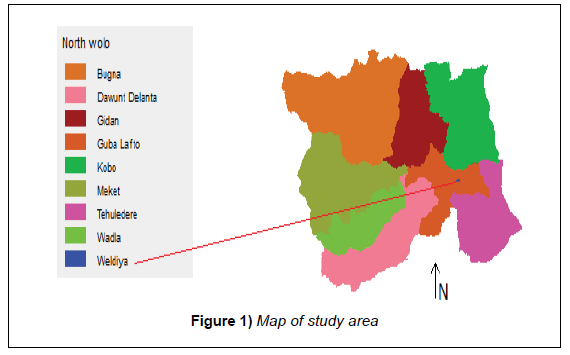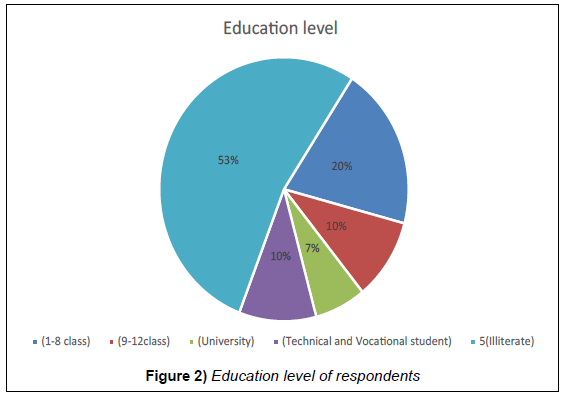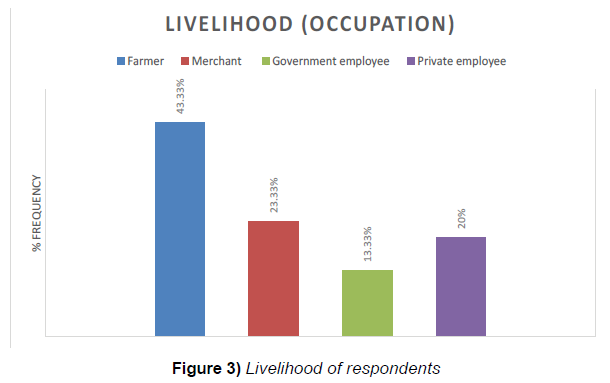Hepatitis B co-infection in HIV AIDS patients in Woldia, Ethiopia
Received: 29-Mar-2018 Accepted Date: Apr 19, 2018; Published: 26-Apr-2018
Citation: Abatenh E, Asmamaw A, Hiluf L, et al. Hepatitis B co-infection in HIV AIDS patients in Woldia, Ethiopia. J Microbiol Biotechnol Rep. 2018;2(2):43-46.
This open-access article is distributed under the terms of the Creative Commons Attribution Non-Commercial License (CC BY-NC) (http://creativecommons.org/licenses/by-nc/4.0/), which permits reuse, distribution and reproduction of the article, provided that the original work is properly cited and the reuse is restricted to noncommercial purposes. For commercial reuse, contact reprints@pulsus.com
Abstract
Hepatites B is one of liver infection resulting from the presence of viral agents. HIV infected individuals are more susceptible to hepatitis B viral infection as their disease progresses in to AIDS. Now a day, Hepatites B is present in HIV infected patients. The aim of this study was to investigate medical information and to get there perception regarding to co-infection as well as to assess associated risk factors for Hepatites B abnormalities among HIV positive patients in Woldia General Hospital, Ethiopia. Questionnaire form were filled up appropriately. They are also forward relevant characteristics. HIVAIDS patients co-infected with Hepatites B was studied. A total of 30 patients were included here. Different social groups were participated during in the time of study. From the total study population 46.7% are males and 53.3% are females. They have variety of personal characteristics. Most of them 53% were illiterate and 43.33% survive in agricultural practice. The major associated risk factors facilitate for co-infection were unprotected sexual habit, screening with variety of pathogens, sharing unsterilized personal equipment’s and illegal drug use. The basic point of reason had both weak immunity system and low CD4 cell count were commented from respondents. To solve the problem first, free from unsecured sexual intercourse who had already Hepatitis B. Second, sterilizing equipment’s. Lastly, avoiding illegal drug usage. In overall patients should have to get a vaccine. Finally they had good common understanding on medical aspects.
Keywords
(HBV) Hepatitis B Virus; HIV (human immunodeficiency Virus); AIDS (acquired immunodeficiency syndrome); Co-infection; Risk factor
Introduction
Hepatitis B is a dieases caused by hepatits B virus that is attack the liver. The virus is responsible for lifelong liver infection, liver cirrhosis, liver cancer and liver failure and subsequent death. HBV is the major health proplem in different parts of the world [1,2]. It is potential for morbidity and mortality in HIV patients due to both are share uniform way of transmission pattern then the possibility of coinfection leads to high/more chronic [3-6]. HIV AIDS patients are sensitive for opportunistic infection and co-infection especially in Hepatitis B virus [7]. The presence of hepatitis B virus (HBV) in patients infected by the human immunodeficiency virus (HIV) leads to a higher incidence of liver disorders due to persistence and recurrence of HBV infection [8]. HIV/AIDS is one of the most crucial public health challenges, particularly in low and middle-income region. In Ethiopia the rate of transmission is increase time to time because of the recent development of casual attitude towards sex, degradation of traditional and indigenous value.
There has been no published papers reported in our hospital. In addition to this, There is no studies was conducted regarding to hepatitis B virus coinfection in HIV AIDS patients in Woldia town up to yet. Therefore, bearing this in mind this study was conducted. The aim of the research is
1. To know clinical sign and symptoms of HIV AIDS patients coinfected with in the HBV.
2. To explore associated risk factors of HIV AIDS patients coinfected with in HBV.
3. To identify the major reason for exposing/ screenning of HIV AIDS patients coinfected with oporunistic infection.
4. To assess control and preventation mechanism for HIV positives not easly susceptible for HBV.
Material and Methods
Description of the study area
Semien Wollo (North Wollo) is one of 10 zones of the Amhara Region of northern Ethiopia. It is bordered on the south by Debub Wollo (South Wollo), on the west by Debub Gondar (South Gondar), on the north by Wag Hemra, on the northeast by Tigray Region and on the east by Afar Region; part of its southern border is defined by the Mille River. It is located 521 kilometer away from Addis Ababa. The global positioning system coordinates of Woldia in terms of latitude and longitude indicate that 11° 49’ 59.99” N and 39° 40’ 59.99” E respectively. The elevation is 2,112 meter above sea level. Woldia has an estimated total population of 46,139 people. Out of this 23, 000 are males and 23,139 are females [9] (Figure 1).
Sampling technique
Purposive sampling technique were applied/used for the selection and inclusion of representative HIV AIDS patients co infected with Hepatitis B, who alrady attended in Woldia General Hospital.
Sample size
For this paper, 30 individuals/informants were selected for the study of HIV patients co-infected with Hepatitis B. Due to finacial constraints, lack of adequate resource and shortage of study time interval the sample size become minimized.
Study population
All necessary data were taken/acquired from patients visited in hospital and different social groups who inhabitants in the area. HIV-positive individuals seen at Hospital they are actively participated. The subjects recruited for this study were confirmed HIV/AIDS patients, presenting with HBV complications. The duration of HIV/AIDS infection showed that those with prolonged AIDS. All HIV patients already tested for the presence of HBV and also the final screening result showed that positive.
Study design
A Hospital based cross sectional study design was conducted among HIV AIDS patients who visited in the hospital from January up to July 2015, in Woldia town, Ethiopia. The selection of Woldia town had been based on the accessibility, easy for transportation, high number of people live together and the presence of general hospital that provide health care for the society.
Data type and data source
The mechanism of gathering data were accomplished/supported in qualitative data type. Furthermore, primary data were sourced/obtained from respondents/hospitalized patients.
Data collection technique
The primary (demographic, socio- economical and epidemiological) data were collected directly from patients who willingness for interview and forward enough information about listed research objective. Focus group discussion were constructed. Then, participants were interviewed by using a semi structured questionnaire, in a local Amharic next translate to English language.
Open and closed ended type questionnaire were prepared/developed and distributed for the study sample population. Finally, relevant medical and behavioral data were collected. All section of questionnaire were pre-tested before finalization.
Statistical analysis
Data was checked for its completeness before the analysis was done. Then, all necessary data were organized, entered and analyzed by using SPSS V 20.0. Descriptive statistics (mean and percentages) method were used/applied to characterize study subjects. The way of presentation and interpretation of the data was made and explained in a form of table, graph, pictogram and percentage value (Tables 1-3).
Table 1: Associated risk factors HIV AIDS patients co infected with hepatitis B
| Variable | Number (N) | Percentage (%) value |
|---|---|---|
| Screening with opportunistic infection | 2 | 6.66% |
| Chewing chat, smoking cigarette and drinking alcohol | 2 | 6.66% |
| Un protected sexual intercourse with single and multi-sexual partner | 5 | 16.66% |
| Un protected sexual intercourse with single and multi-sexual partner | 6 | 116.66% |
| Using and sharing unsterilized personal equipment’s (contaminated needles) for ear piercing and tattooing | 4 | 13.33% |
| Vertical transmission | 2 | 6.66% |
| Un safe blood transfusion | 2 | 6.66% |
| Malnutrition | 1 | 3.33% |
| Low socio economic status | 1 | 3.33% |
| Contacted with secreted body substances (compounds) together | 4 | 13.33% |
| Immunity system destruction due to HIV from time to time | 3 | 10% |
Table 2: Sign and Symptoms for HIV ADIS patient’s co infected with hepatitis B
| Variable | Number (N) | Percentage (%) value |
|---|---|---|
| Body weight loss | 4 | 13.33% |
| Color change of eye (jaundice) | 3 | 10% |
| Variable body temperature | 1 | 3.33% |
| Diarrhea | 2 | 6.66% |
| Right upper quadrant pain and pain in liver body organ | 3 | 10% |
| Vomiting | 1 | 3.33% |
| Fever | 1 | 3.33% |
| Chills | 1 | 3.33% |
| Weakness of body and swelling part of body or tiredness | 4 | 13.33% |
| Nausea | 2 | 6.66% |
| Headache | 2 | 6.66% |
| Loss of appetite | 1 | 3.33% |
| Enlargement of liver , cirrhosis and liver cancer eventually develop | 4 | 13.33% |
Table 3: Prevention and control mechanism for HIV AIDS patient’s not to be co infected with hepatitis B
| Variable | Number (N) | Percentage (%) value |
|---|---|---|
| Avoiding blood and other body fluid close contact with infected person | 3 | 10% |
| Keeping personal hygiene and environmental sanitation | 3 | 10% |
| Stopping excess alcohol consumption | 2 | 6.66% |
| Using condom, introducing one to one mechanism for sexual intercourse or implement sexual abstinence | 4 | 13.33% |
| Using wisely given drug by physicians | 5 | 16.66% |
| Sterilizing contaminated foodstuff completely | 3 | 10% |
| Do not sharing personal equipment’s | 6 | 20% |
| Stopping the participation in sexual intercourse with many infected partner | 4 | 13.33% |
Ethical consideration
Ethical clearance was taken from Woldia General Hospital medical directorate office. Full permission were allowed to conduct the research then all participants were informed about the objective and procedure profoundly. Privacy and confidentiality well maintained. Each questionnaire were numerically coded without any personal identification. Later, our consent result was presented to physicians working at the hospital to cheek up the relevancy of clinical based data.
Result
Socio-demographic profile (characteristics) of individuals
A total thirty study populations (potential candidates) are selected and clustered in to five groups. One group at least hold ten study individuals. Then hot discussion lesson continued and they also provide all necessary relevant response (characteristics). The research outcome indicated that out of them 46.7% (1) are males and 53.3% (2) are females. The mean age size of patients were 33 ± 1 years included here. The marital status of patients 36.66% (10) from the population is married, 46.66% (1) is single and also the remaining 16.66% (7) is divorce. Based on research finding, All HIV AIDS subjects are co-infected with HBV and they are used as a source of information. All respondents also have common understanding about the causative agent which is already virus. Economic status of respondents on the basis of monthly and annually generated income 6.66% (4) participants are grouped in first class, 20% (8) respondents are clustered in medium class and 73.33% (11) of individuals are found in third class (live in under poverty level) (Figure 2).
The reason for co-infection within HBV based on informant consensus 20% [8] were told us/ announced with in brief description: lack of well-organized acquired and innate immunity system, 43.33% [12] were explained white blood cells and CD4 cell gradually become very low. The last 36.66% [10] were forward detailed explanation that HIV is develop immunity system problem which leads to immunity function become retarded. At that moment cannot effective in HBV prevention (Figure 3).
Discussion
HBV infection had negative impacts on history of HIV seropositive. Both HBV and HIV are viruses that share certain epidemiological characteristics such as risk populations and transmission routes. The risk of chronic hepatitis B is higher in co-infected HIV patients. HIV/HBV co-infected patients showed worse clinical and immunological features [13].
The majority of the participants in the current study were women (53.3%). The predominance of women in the present study outcome were correlated already reported in previous time [14].
The finding that HIV seropositivity leads to increased prevalence of HB. The prevalence of HB seropositivity increased with deteriorating immune status reflected by lower CD4+ cell counts. Increasing prevalence of HBeAg with worsening HIV-induced immunosuppression. Reasons for getting opportunistic infection also related to CD4 cell count decline gradually. This finding was consistent with other studies done on related title [10,14,15]
The main possible factors for co-infection rate leads (brings) to high: Smoking, blood transfusion, alcohol consumption, sharing razor for tattooing, injecting drug use, unsafe injection, unusual drug addiction, unsafe homo and hero-sexual habit (lifestyles), unsafe surgical history, tooth extraction and low CD4 count are baseline characteristics and also supported with many coherent studies in different place [1,2,5,6,8,12,13,16,17].
In the current study, all respondents have knowledge toward prevention practices on HBV. Responses to preventive/protective measures are frequently wash hands, used protective instruments, sterilizing equipment’s, disinfecting materials and participating in vaccination program. This finding was resembled with the previous study from Northwest Ethiopia and India that reported a good knowledge of the study participants on HBV infection [18,19].
The present study survey showed that HBV-infected patients had different socio-demographic characteristics. Based on the finding of this study, major clinical manifestations such as fever, fatigue, loss of appetite, jaundice, rash, joint pain and headache were confirmed with other papers also [11,20].
Conclusion
Hepatitis B is one of the leading cause of acute and chronic in HIV/AIDSinfected patients in Woldia town. Thus, the patients can get immediate treatment and needs intensive care in order to prevent them from health devastation. Generally, in this study many possible risk factors had explored and identified for respective/contributive opportunistic infections.
Recommendation
Researchers should be initiated to do more investigation regarding to seroprevalence with in HIV positive individuals. For North Wollo administrative zone to develop, provide and manage treatment options as well as crating public awareness campaign against HIV/AIDS and its opportunistic infections frequently.
Acknowledgement
The research paper submitted to the department of biology the partial fulfillment of requirements degree of science in Biology. First we would like to acknowledgement our God to support us who give the power and endurance to accomplish our goal. The second gratitude goes to our unique Miss Rahel Gebeyehu for her valuable critical comments and contractive advice. In the third place we thank Biological Science department head Mr. Mihretu Tarekegn for provide unrestricted supporting our work by different means. Finally, we would like to acknowledge Woldia General Hospital Society for their excellent willingness and unfailing cooperation during the survey and we would like thankful to our interview informants and questionnaire respondent. We also would like to thank our family for their continuous support for our academic success and financial support.
REFERENCES
- Letebrhan W, Tsehaye A, Rashmi B, et al. Sero prevalence of HBV and associated risk factors among HIV positive individuals attending ART clinic at Mekelle hospital Tigray Northern Ethiopia. AIDS Res Ther. 2016;13:1-7.
- Mohammad AD, Nasrin M, Ebrahim F, et al. Hepatitis B Virus Infection Serology and the Associated Risk Factors Among Patients With HIV in Shiraz Iran. Shiraz E-Med J. 2015;16:1-5.
- Akosua AA, Richard OA. Prevalence of HIV and hepatitis B Co-infection in Ghana: a systematic review and meta-analysis. AIDS Res Ther. 2016;13:1-9.
- Kranthi K, Shashiraja P, Indira B. Co-infectionwith hepatitis viruses among HIV-infected individuals at a tertiary care centre in South India. Tropical Doctor. 2011;1-2.
- Nwako O, Mbata G, Ofondu E, et al. The Seroprevalence of Hepatitis B Viral Infection in HIV Tested Positive Individuals in Owerri Imo State Nigeria. AIDS Clin Res. 2013;5:1-4.
- Manuela A, Costinela G. Characteristics of Hepatitis B Co-infection and Disease Evolution in HIV-Positive Paediatric Patients in Romania. Balkan Med J. 2013;30:263-7.
- Simnikiwe HM, Theresa MR, Difuro PM, et al. HBV/HIV co-infection: The dynamics of HBV in South African patients with AIDS. S Afr Med J. 2012;102:157-162.
- Aline CV, Maria RPAT, Vera LPS, et al. Epidemiological analysis of serological markers of hepatitis B in HIV+ patients from Curitiba and metropolitan region. J Bras Patol Med Lab. 2015;51:17-21.
- Central Statistical Agency of Ethiopia. 2007.
- Jayeeta S, Debraj S, Bhaswati B, et al. Baseline characteristics of HIV & hepatitis B virus (HIV/HBV) co-infected patients from Kolkata India. Indian J Med Res. 2016;143:636-42.
- Xiaohong C, Chengtao F, Jia L, et al. Recent epidemiological and clinical features of acute hepatitis B in a single center of China. Int J Clin Exp Med. 2015;8:16652-57.
- Gyar SD, Agbo P, Reuben CR. Assessment of Hepatitis B Co-infection among HIV/AIDS patients Attending Antiretroviral Therapy (ART) Clinic in Garaku, central Nigeria. Research Journal of microbiology. 2014;9:232-8.
- Monia P, Cristina S, Monica DF, et al. Prevalence and characteristics of HIV/HBV and HIV/HCV coinfections in Tuscany. Braz j infect dis. 2016;20:330-4.
- Michael OI, Comfort AD, Oche OA, et al. Prevalence of hepatitis B e antigen among human immunodeficiency virus and hepatitis B virus co-infected patients in Jos Nigeria. J Infect Dev Ctries. 2013;7:951-9.
- Philippa CM, Apostolos B, Amna M, et al. Prevalence and Characteristics of Hepatitis B Virus (HBV) Coinfection among HIV-Positive Women in South Africa and Botswana. PLOS ONE. 2015;10:1-11.
- Bayeh A, Yohanes Z, Wondemagegn M, et al. Seroprevalence of hepatitis B and C viruses and risk factors in HIV infected children at the felgehiwot referral hospital Ethiopia. BMC Research Notes. 2014;7:1-6.
- Bùi VH, Kanxay V, Nguyn V. HBV and HCV Coinfection among HIV/AIDS Patients in the National Hospital of Tropical Diseases Vietnam. AIDS Research and Treatment. 2014;581021:5.
- Abdnur A, Berhanu W, Kassahun H, et al. Assessment of knowledge, attitudes and practices toward prevention of hepatitis B virus infection among students of medicine and health sciences in Northwest Ethiopia. BMC Res Notes. 2016;9:1-7.
- Vishal M, Sakshi K, Harmesh S. Knowledge, Attitude and Practices about Hepatitis B and Infection Control Measures among Dental Students in Patiala. Journal of Dental and Allied Sciences. 2017;6:65-9.
- Yong-Tao H, Chao S, Cai-Xia L, et al. Clinical features and outcome of acute hepatitis B in pregnancy. BMC Infectious Diseases. 2014;14:1-7.







